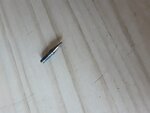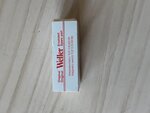userx2
Full Member level 3

Here is a picture of one of my tips.
- - - Updated - - -
This is the replacement temperature magnaswitch I installed.
There is no heat when no tip is fitted. So it appears to be working, at least partially.
- - - Updated - - -
I just measured the station power consumption and it switches between 53 an 4.2Watt.
That means it is switching on and off correctly.
I measured the temperature with an IR thermometer to be around 312degC and 343 with a thermocouple.
Is this correct or is there still a temperature issue?
This tip is no.8
- - - Updated - - -
This is the replacement temperature magnaswitch I installed.
There is no heat when no tip is fitted. So it appears to be working, at least partially.
- - - Updated - - -
I just measured the station power consumption and it switches between 53 an 4.2Watt.
That means it is switching on and off correctly.
I measured the temperature with an IR thermometer to be around 312degC and 343 with a thermocouple.
Is this correct or is there still a temperature issue?
This tip is no.8




